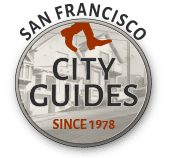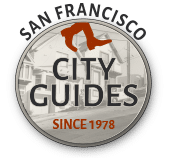San Francisco Tour Tales
The Ferry Building
The Ferry Building, a bustling city landmark built in 1896, sits grandly on the Embarcadero at the foot of Market Street overlooking the Bay and welcomes thousands of locals and tourists daily. In its most recent incarnation, the Ferry Building’s busy market/food hall features vendors selling locally-sourced produce and artisan goods—and upstairs are the Grand Nave and two floors of prestigious office space, with a 660-foot skylight allowing light to shine down on all the floors.
Above it all, the Ferry Building’s tower stands tall on the waterfront, an iconic San Francisco view at the entrance to one of the world’s best natural harbors.
Many of us who have lived in the Bay Area for a few decades remember the Ferry Building when it was a forlorn, forgotten building on a declining waterfront, hidden by a double-decker freeway. It was not until the Loma Prieta earthquake in 1989 and much political wrangling that the freeway came down in 1992 and the building was restored to its former glory.
What a lot of people do not realize is just how critical the building was as an entryway to the city before the opening of the San Francisco–Oakland Bay Bridge in 1936, and the Golden Gate Bridge in 1937. Commuters as well as U.S. presidents arrived through the Ferry Building.
The city’s geographic position, with water on three sides and San Mateo County to the south, meant that in the era of transcontinental train travel, journeys began or ended across the Bay in Oakland—and passengers departed or arrived in San Francisco by ferryboat from the Ferry Building. Once they arrived, they needed to get to other areas of the city. Horse-drawn streetcars first appeared in 1851, and then were replaced by steam, cable, electric, and later motor buses and trolley coaches.
Ferryboats went from every major Bay port to San Francisco, and places in between. The ride from the Ferry Building to Vallejo, 30 miles, was the longest, and the fast Monticello Line ferryboats could make the trip in an hour and forty-five minutes. Oakland to the Ferry Building took eighteen minutes.
The aptly named “Six-Minute Ferry” was the shortest ride, traveling from Morrow Cove in Vallejo to Crockett, across the Carquinez Straits.
After taking a ferry from San Francisco, a traveler could catch a train in Oakland to faraway places, or a commuter might board an electric train in Alameda or Sausalito to get home. In the early 1930s, 50 million commuters and visitors passed through the Ferry Building annually. Riding the ferry was a way of life, an efficient, relaxed, and congenial way to pass the time. Compare that to automobile commuters today, frustrated when trying to get home, and stuck in their cars on a bridge on-ramp in rush-hour traffic.
Over the years, in addition to the thousands of daily commuters going in and out of the Ferry Building via the second floor (the the ground floor was used for luggage), there have been gatherings in the building and parades that started at the Ferry Building and proceeded up Market Street. These gatherings celebrated holidays, victorious sports teams, and returning soldiers, and protested wars and controversial labor practices.
Architect A. Page Brown designed the 660-ft. long, 48-ft. wide Grand Nave, which ran the full length of the building, to be a great public gathering space. The Grand Nave was used for many exhibits and banquets. In 1901, San Franciscans turned out by the thousands to welcome President William McKinley, the 25th President of the United States, to San Francisco. In the nave, the President stood on an elevated stand decorated with white carnations from 8 to 11 p.m., while well-wishers filed by waving small American flags. “Every person attending the reception is requested to come prepared for this unique compliment to the Nation’s chief. . . Myriads of little red, white and blue electric globes will brighten the long tessellated hall,” said an article in the May 14, 1901, San Francisco Call.
Today, the Ferry Building is enjoying its new role. Tourists and locals throng to the food stalls and Farmers’ Market. Ridership is booming on the ferries. Commuters have rediscovered what ferry riders enjoyed in the heyday of ferries: it’s a pleasant way to travel. The dark days of the Embarcadero Freeway and a declining waterfront seem long gone. The jewel of the waterfront is here to stay.
Sources
Port City: The History and Transformation of the Port of San Francisco, 1848-2010. Corbett, Michael R, Mike Buhler, and Jay Turnbull. San Francisco, CA: San Francisco Architectural Heritage, 2013.
Simple Pleasures Begin With Ferryboats. Nancy Olmsted. San Francisco, CA: National Maritime Museum Association, c1999.
A Negotiated Landscape: The Transformation of San Francisco’s Waterfront since 1950. M. Jasper Rubin. Chicago, IL: Center for American Places at Columbia College Chicago, 2011.
Inventing the Dream. Kevin Starr. New York: Oxford University Press, 1985.







